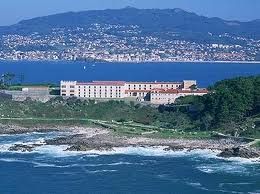
Baiona (Bayona) Galiza SpainIn the days of the famous voyages of Christopher Columbus, Baiona was the first port to hear about the discovery of America and today a replica of the Pinta is permanently moored in the harbour. Baiona’s fascinating history attracts almost 35,000 tourists each summer with yachts from all over the world sailing into its port in preparation for their transatlantic crossing. It must have been quite a sight to see the English and Dutch ships sailing through on their way to the battle of Virgo in 1702. In those days they had fire ships which would bring down the enemy by setting their ships ablaze. It is said that one such ship carrying a great deal of treasure sank to the bottom of the Ria de Vigo which no doubt has attracted a lot of divers since!  Standing majestically on the point guarding the port is the 10th century Monterreal Fortress which protected the town from enemies and pirates. One of the most notorious attacks was by Sir Francis Drake in 1585. Back then the people of Baiona lived within the walls of the fortress but later it became a residence for military governors. There are three towers; one with a hidden bell to raise the alarm if there was an attack, one was to defend the port and the other acted as a lighthouse. Today part of the fortress has been converted into the Parador Baiona (Hotel Conde de Gondomar) where guests can enjoy spacious, elegant accommodation with spectacular views of the ocean and sunsets over the Ria and the Cies Islands.
Standing majestically on the point guarding the port is the 10th century Monterreal Fortress which protected the town from enemies and pirates. One of the most notorious attacks was by Sir Francis Drake in 1585. Back then the people of Baiona lived within the walls of the fortress but later it became a residence for military governors. There are three towers; one with a hidden bell to raise the alarm if there was an attack, one was to defend the port and the other acted as a lighthouse. Today part of the fortress has been converted into the Parador Baiona (Hotel Conde de Gondomar) where guests can enjoy spacious, elegant accommodation with spectacular views of the ocean and sunsets over the Ria and the Cies Islands.
In the older parts of the town you will find names of places written both in Spanish and Galego which is an ancient language still spoken in this region. The Old Town is circular with only three ways in from either the Santa Liberata Square, the Padre Fernando square or the Holy Trinity Cross. The cross was built in the 15th century and is one of many popular attractions along with Our Lady of the Rock, the Virgin Mary, which stands 15 metres high and is set in the granite rocks of San Roque Hill. Her crown was made in China and holding a boat-mirador in her hand, her face and hands are carved from white marble.  Down by the seafront is a wonderful boulevard lined with expensive boutiques, delightful fish restaurants and outdoor cafes. A ferry boat can take you out to the Isle of Cies where you can either relax on the secluded beaches or stroll through the bird sanctuary. Just south of the Parador is a spectacular drive along a coastal road that leads to a Celtic settlement on top of Santa Tecla mountain, as well as the attractive fishing village of A Guarda. The Mino valley may also be of interest to those who wish to see where the Albarinho wine is produced.
Down by the seafront is a wonderful boulevard lined with expensive boutiques, delightful fish restaurants and outdoor cafes. A ferry boat can take you out to the Isle of Cies where you can either relax on the secluded beaches or stroll through the bird sanctuary. Just south of the Parador is a spectacular drive along a coastal road that leads to a Celtic settlement on top of Santa Tecla mountain, as well as the attractive fishing village of A Guarda. The Mino valley may also be of interest to those who wish to see where the Albarinho wine is produced.
Eleven kilometres from town is Groba Hill with breathtaking views of the Rias Baixas. There are beautiful paths and cobbled ways leading up the hillside, and wild horses can be seen grazing. These animals were recorded as far back as the Bronze Age in paintings that were discovered high in the hillside. At the end of May there is a fascinating ancient Galician tradition called Curros where cattle raisers herd the horses from the mountains and split them up branding the new colts and shearing the mares. Some of them are sold off as well and others are moved to different areas. Baiona is a town with an extraordinarily colourful history. With so many activities such as horseback riding, golf, hiking, sailing and paragliding to keep you amused it is no wonder it attracts so many visitors each year. |